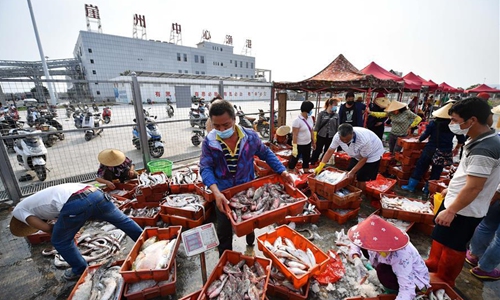China can achieve growth goal as retail sales, industrial output likely to rebound after weak Jan-Feb
Retail sales, industrial output likely to rebound after weak Jan-Feb

People trade fish at a fish market of the Yazhou central fishing port in Sanya, south China's Hainan Province, March 10, 2020. More than 400 fishing boats in the port have started to work as the province's fishing industry resumed operation. (Xinhua/Guo Cheng)
Growth figures for China's retail sales, industrial output and fixed-asset investment for January and February are expected to slow to an unprecedented low of only 3 percent, as measures to contain the new virus outbreak unavoidably battered the economy.
Since the outbreak of the coronavirus, China used partial or full lockdown measures in January and February to fight the disease. While these measures brought the epidemic under control, they inevitably hammered the economy in the short term.
Analysts said China's retail sector, a major driver of GDP, was probably to be hit the hardest, especially catering, tourism and entertainment.
Liang Hong, chief economist of China International Capital Corp, said in a note that China's retail sales growth rate for January and February is expected to decline to 2 percent from last December's 8 percent.
In addition, Liang predicted another important economic indicator - value-added industrial output - will slow to around 3 percent in the first two months from 6.9 percent seen in December 2019, as production was suspended and hasn't returned to normal in part due to labor shortages.
Meanwhile, the country's fixed-asset investment growth rate is forecast to drop to about 3.5 percent from 5.4 percent in 2019, according to Liang.
However, compared with these widely anticipated drops, more attention should be paid to signs of an economic rebound after the end of the outbreak, according to analysts.
The recovery of China's economic activities as of mid-March beat expectations, said Tian Yun, vice-director of the Beijing Economic Operation Association.
Currently, even the severely hit catering industry in China has reported 60 percent resumption among large restaurant chains, while a number of local governments have rolled out policies to boost the recovery of the tourism sector, with a longer Labor Day holiday to be expected in May.
Cong Yi, a professor at the Tianjin University of Finance and Economics, told the Global Times on Sunday that domestic demand is expected to recover rapidly starting in the second quarter, with the only uncertainty being whether the fast-spreading epidemic overseas will affect China's exports.
Due to the epidemic, the trade slid 9.6 percent year-on-year in the first two months of the year to 4.12 trillion yuan ($588 billion).
But Tian told the Global Times on Sunday that rising demand for medicines and medical gear in fighting the disease overseas will drive China's exports over the next few months.
With ample liquidity to guarantee stable cash flow at enterprises and households, China's GDP growth may still be able to achieve the goal of 6 percent this year, Liang said, noting that the country's unique huge deposits help cushion shocks from black swan events.
On Monday, the People's Bank of China, the country's central bank, will implement targeted reserve requirement ratio cuts of 0.5 to 1 percentage points for eligible lenders, freeing up to 550 billion yuan in long-term funds among lenders.
"China will likely contribute more to global GDP growth in 2020 than it did the previous year, as the US may see zero growth and the EU post a significant contraction," Tian said.
The country's key standing in the global industrial chain will be further cemented amid the epidemic, as domestic companies have a great opportunity at this time to invest in research and development for upgrading, Tian said, noting that domestic economic development will move at a faster pace in 2021.

